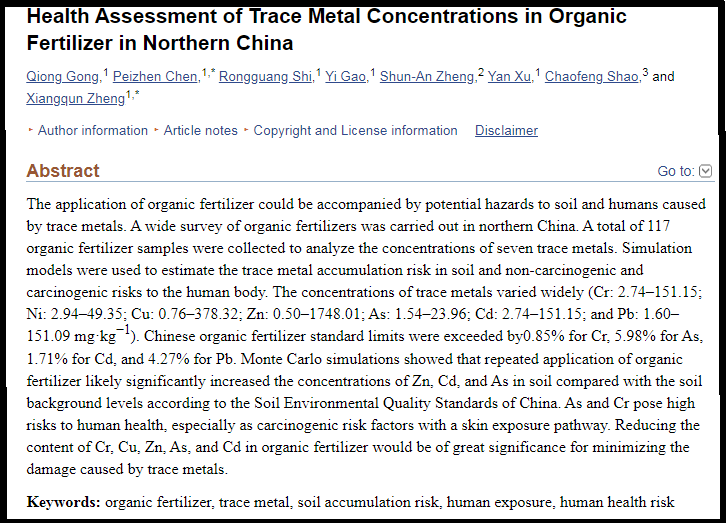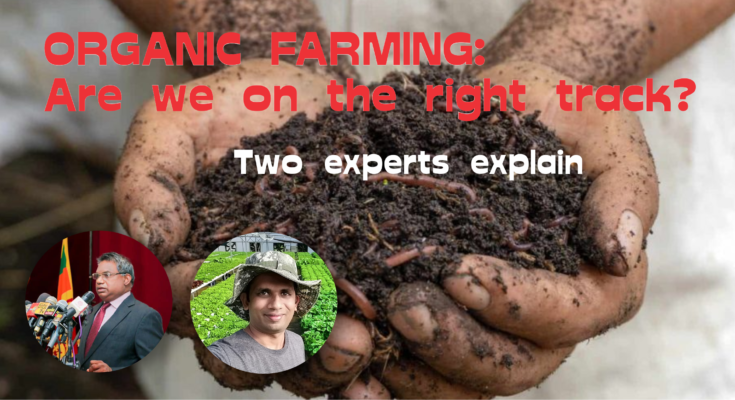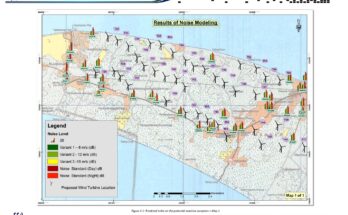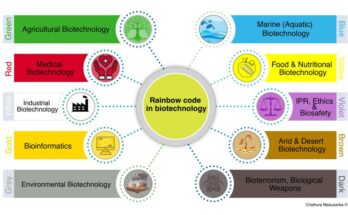With the aim of converting Sri Lankan agriculture in to a 100% organic one, the Sri Lankan government took a policy decision to ban the import of agrochemicals with immediate effect. This decision came as a surprise to many in the agriculture and other related fields. Many discussions began to surface pointing out the pros and cons of going organic as a country.
In this article we try to present views of two experts in the fields of agriculture and Chemistry to broaden your horizons about going 100% organic in Sri Lankan agriculture.
We were on track to minimize the usage of agrochemicals with a long term to plan to go for an optimum balance between organic and inorganic fertilizers – Sanjana Ravindu

In a recent webinar organized by Manthrana, serandibpuwath and elearning.lk websites, well-known agronomist Mr. Sanjana Ravindu talked about this decision and how we should proceed ahead towards a organic based agriculture.
“It’s a fact that converting to organic agriculture can reduce the output of any agricultural system. So, the question is, what the next step will be, when the output of an organic based system is not adequate enough to fulfil the demand of a country? It’s obvious that we will have to import those products from other countries that use agrochemicals. For an example, things we already import that include onion, potato, chili, lentils, and wheat comes from countries that heavily depend on agrochemicals for the production of these agricultural commodities. For an example India still uses some agrochemicals that we banned here in Sri Lanka 20 years back. So, what is the assurance we get to say the products we import are produced in a healthy production system? “ Sanjana asks
In his talk Sanjana further explained what we can do to cut down the use of excess agrochemicals in our agricultural production systems.
“Right now, as a country we need to grow whatever we can using whatever the land we have using the best technologies, modern farming methods and best organic and chemical fertilizer combinations to get the maximum possible production. “
“Agriculture Department with the help of our own scientists and experts have been engaged in this process for over decades, and as a country we already have come a long way towards that goal. For an example Sri Lanka had imported 60% of the total rice demand of the country in 1940s, but by 2012 Sri Lanka achieved the self-sufficiency in Rice producing 99% of the total demand of the country.”
“These crop improvement programs in rice and other crops have been able to increase the pest and disease resistance of crops lowering the need of Agrochemicals usage in those crops. Apart from these we were using many other strategies to reduce the agrochemical use in Sri Lankan agriculture. I can list some of them as follows,
- Mechanization
- Adopting new farming technologies like Protected agriculture, New Irrigation systems,
- IPNS system (Integrated Plant Nutrition System) to determine the exact nutrient need of a crop which will help reduce the fertilizer usage. This system also encourages the use of organic fertilizer.
- Integrated Pest Management – Reduce the use of pesticides
- Increase the awareness on optimum fertilizer usage and use technologies like Leafe Color Index to determine the exact nutrient type and amount a crop need.
- GAP(Good Agricultural Practices) program – one of the main targets of this system is to minimize the agrochemical use and make the production as healthy as possible.

So, I think if we continue to improve ourselves with these programs and utilizing other modern agricultural technologies, we can increase the production of our agriculture system keeping the chemical fertilizer usage in a minimum level. “ Sanjana concluded.
Chemistry of Organic Fertilizers: Another Major Factor to Consider; Prof. Gamini Rajapakshe
Meanwhile Prof. Gamini Rajapkashe in a special writeup to the Sri Lankan scientist magazine explained few other factors to consider when we go towards organic agriculture.

“Organic fertilizer is a product manufactured using manure and plant plants. The presence of organic matter in organic fertilizer is important for improving soil structure to retain water and plant nutrients. The carbon-rich organic fertilizer with nitrogen, phosphorus and potassium helps microbes to flourish. The microbes can break down complicated structures present in organic fertilizer and make nutrients available for plants through natural biological processes. However, this is a slow process and hence the required nutrients may not be available in sufficient amounts as and when required by the plants. Since organic fertilizer is composed of complicated molecules which are usually insoluble in water, the run-off of organic fertilizers into water streams is relatively low. Organic fertilizer can reduce the amount of chemical fertilizer commonly used when applied as a supplement to chemical fertilizer. Also, the damages to plants are less when organic fertilizers are used.” Prof. Rajapakshe explained the positive side of organic fertilizers.
Speaking further prof. Rajapkashe who is an expert in chemistry explained the factors that we have to be careful about in using organic fertilizers in agriculture.
“The compositions of organic fertilizers depend on the raw materials used. The raw materials may contain unwanted toxic substances that can contaminate the final product. Since carbon-rich, water absorbing matrix is an ideal environment for various microbes to grow, even the pathogens and pests can grow within the organic fertilizer medium thus leading to various plant diseases. Therefore, proper analysis of the constituents of organic fertilizer in terms of its nutrient values such as C:N ratio, N/P/K in right ratios, micro-nutrients, chemical and biological contaminants is essential. Since, the contaminants in the organic fertilizers depend strongly on the localities where the products are manufactured the quality of the products also depends on the locality of production. Therefore, switching to organic fertilizer only within a day could lead to problems. When we take all the factors in to consideration, gradual transition to organic fertilizers from chemical fertilizers is the most accepted way of implementing this kind of a transition to safeguard ecosystem and the environment. Outright banning the use of chemical fertilizers and agrochemicals is not a wise decision since that may lead to problems in agriculture with regard to adequate availability of alternative fertilizer and pest and weed management systems. First of all, adequate amounts of organic fertilizer should be available within the country. Suitable mechanism to apply large quantities of organic fertilizers required for tea plantation in the hilly areas should be developed. If organic fertilizer is to be used on its own without any chemical fertilizer supplement, then the products must be developed so as to get the required nutrients in sufficient amounts as and when required by the plants.”
In a fully organic farming system fulfilling the demand for the required fertilizer is a challenge, Prof. Gamini Rajapakshe explained the drawbacks that can arise in such a situation.
“As of now, the local production of organic fertilizers is insufficient to meet the demand of the consumers. As such, there are proposals to import organic fertilizers from countries such as China. Therefore, it is of vital importance to investigate the quality of organic fertilizer produced in such industrialized countries. As such, available scientific information in standard journal articles must be thoroughly studied. International Journal of Environmental Research on Public Health, 2019 March 16 has published an article on trace metal concentrations of organic fertilizer in Northern China. The researchers have analyzed 117 different organic fertilizer formulations and measured their heavy metal contents.”

“Quoting results that they have published, the concentrations of heavy metals in these formulations are as follows: Chromium 2.74 – 151.15 mg per kg or ppm, Nickel 2.94 – 49.35 ppm, Copper 0.76 – 378.32 ppm, Zinc 0.30 – 1748.01 ppm, Arsenic 1.54 – 23.96 ppm, Cadmium 2.74 – 151.15 ppm, Lead 1.60 – 151.09 ppm. While all these heavy metals in these concentrations are harmful to human and animal health the most dangerous ones are chromium, arsenic, cadmium and lead which are exceeding Chinese Organic Fertilizer Standards by 0.85%, 5.98%, 1.71% and 4.27% according to the researchers who published this article. They have used Monte Carlo simulations to investigate the accumulation of these heavy metals in crops due to repeated application of fertilizer on soil.”
Not only heavy metals!!
According to Prof. Rajapakshe, apart from heavy metals there can be many other contaminants in organic fertilizers, that can cause various health and environmental issues.
“There are many types of organic fertilizers like Compost, Blood meal, Bone meal, Cottonseed meal, Fish emulsion and Feather meal. Animal manures and sewage sludges which are called biosolids are the major components used in making organic fertilizers together with dry leaves of plants, stove and grass. The chicken feed, pig feed and cattle feed are supplemented with various chemicals to stimulate growth and feed efficiency. For example, the chemicals added to chicken feed include arsellinic acid, copper sulfate, cadmium, calcium, chlorine, cobalt, cerium, dysprosium, iron, lanthanum, magnesium, strontium, selenium, titanium, uranium, vanadium and zinc. Not all of these chemicals are metabolized in chicken and most of them are released in the manure. These chemicals are added mainly in large scale farms with more than 10,000 pigs and 5000 cattle are common in these countries.”
“At the same time, up to 200,000 tons of antibiotics are used per annum by humans and administered to farm animals. About 70% are consumed as growth promoters in veterinary farms. China is reported as the largest producer and user of antibiotics. These excessive amounts of antibiotics and their metabolized products accumulate in their manure and eventually end up in organic fertilizer. Such a vast exposure to antibiotics results in the development of bacteria resistant to antibiotics. This antibiotic resistance has become a major issue worldwide and alternatives have to be developed to treat bacterial infections causing diseases. Additionally, organic fertilizer is an excellent medium for growth of various microorganisms and are contaminated with invading weeds. The sterilization techniques are expensive and include heating at desired temperatures for several hours, microwave heating, gamma ray irradiation and beta ray irradiation, the latter two methods are the most efficient but most costly when hundreds and millions of tons are to be sterilized. Sterilization can destroy microorganisms but the medium is favorable for re-contamination and growth. None of the sterilization methods described above can remove heavy metals and antibiotic residues. Therefore, the importing organic fertilizer is a very sensitive issue that has to be tackled with utmost care. The advisors should not have weaknesses of will!”
Views from these two experts clearly show how challenging it is to transit to a fully organic agriculture system as a country. There are many factors to be considered, and many hidden threats too. Few weeks back a group of Agriculturists in an exclusive letter to the President wrote about the possible negative consequences that may arise from this sudden decision. Views from experts always help in taking a decision and also their knowledge in their subject areas should be used to the maximum effect in fine tuning these decisions to get the maximum benefit.




